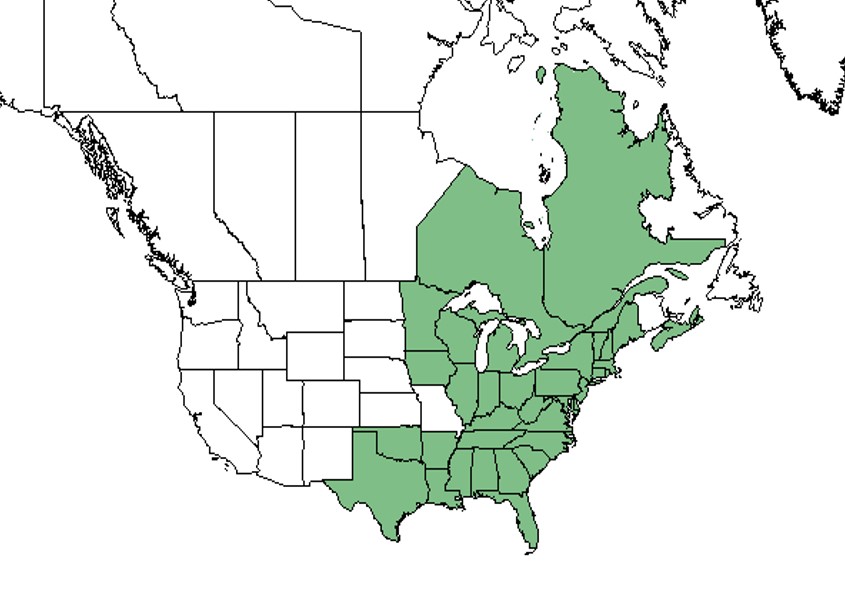Polygala polygama
| Polygala polygama | |
|---|---|

| |
| Photo taken by Gil Nelson | |
| Scientific classification | |
| Kingdom: | Plantae |
| Division: | Magnoliophyta – Flowering plants |
| Class: | Magnoliopsida – Dicotyledons |
| Order: | Polygalales |
| Family: | Polygalaceae |
| Genus: | Polygala |
| Species: | P. polygama |
| Binomial name | |
| Polygala polygama Walter | |

| |
| Natural range of Polygala polygama from USDA NRCS Plants Database. | |
Common names: Racemed milkwort, Bitter milkwort
Contents
Taxonomic notes
Synonyms: Polygala polygama Walter var. obtusata Chodat; P. polygama var. polygama; P. aboriginum Small
Description
"Herbs, whorled or alternate rarely opposite, entire leaves. Flowers lavender, pink, white or yellow, in racemes or spikes, terminating the branches or in terminal corymbs. Flowers perfect, zygomorphic, with 3 small sepals, frequently one of these slightly larger than the others, and 2 larger petaloid sepals (wigs). The 3 petals are united into a tube, 3-lobed at apex, the 2 lateral lobes usually the longer, the center lobe usually lacerate, often thicker in texture; stamens 6-8, united to the corolla tube in 2 rows. Capsule 2 –locular, with one seed in each locule. Seeds dark brown or black, ellipsoid or ovoid, rarely globose, 0.5-3 mm long, usually densely pubescent. The genus has been divided into several genera none of which have distinct characteristics. Orange flowers turn pale yellow on drying, yellow ones bluish green; the pink or lavender ones remain the same color or fade slightly." [1]
"Glabrous biennial or weak perennial herb, 3-5 dm tall, from a tap root; branches erect, slightly radiating from a crown, stems uniformly leafy. Leaves alternate, linear-oblong to oblong-spatulate, 1.5-4 cm long, revolute, apex usually with a sharp mucro, racemes 5-25 cm long; bracts deciduous. Sepals green, with pink or white margins, ca. 2 mm long, wings pink, elliptic , 4-6 mm long, tapered to claws; corolla slightly shorter than the wings, fringed; stamens 8. Cleistogamous flowers in racemes from the base of the plant, either below or just above the surface of the soil, rarely from the lower leaf axils. Seeds black, ca. 3 mm long, densely short-pubescent; aril 2-lobed ½ as the seed body." [1]
Distribution
Ecology
Habitat
In the Coastal Plain in Florida and Georgia, P. polygama has been found in a longleaf pine-mixed-oak-wiregrass association on a sandy hill slope, upland unburned pine woodland with thick vegetation, annually burned longleaf pineforest, piney woods and ridges, and burned areas. [2] It can also occur on xeric sandhills near roadsides. Associated species include Licania michauxii, Balduina angustifolia, Helianthemum corymbosum, Conradina canescens, Pinus palustris, Aristida stricta, Quercus, Verbena rigida, Solanum dimidiatum, Carex, Marshallia obovata and Oenothera fruticosa. [2]
Light levels observed include open and semi-shaded areas. [2] Soil types recorded are white xeric sand and loamy sand. [2]
Phenology
Flowering occurs April and May. [2]
Seed dispersal
This species disperses by explosion mechanisms or by ants. [3]
Conservation and management
Cultivation and restoration
Photo Gallery
References and notes
- ↑ 1.0 1.1 Radford, Albert E., Harry E. Ahles, and C. Ritchie Bell. Manual of the Vascular Flora of the Carolinas. 1964, 1968. The University of North Carolina Press. 656. Print.
- ↑ 2.0 2.1 2.2 2.3 2.4 Florida State University Robert K. Godfrey Herbarium database. URL: http://herbarium.bio.fsu.edu. Last accessed: July 2015. Collectors: James R. Burkhalter, M. J. Jordan, R. A. Norris, R. Komarek, Wilson Baker, Robert K. Godfrey, Loran C. Anderson, Bill Boothe, Marcia Boothe, R. F. Doren. States and Counties: Florida: Escambia, Jackson, Leon. Georgia: Decatur, Grady, Thomas. Compiled by Tall Timbers Research Station and Land Conservancy.
- ↑ Kirkman, L. Katherine. Unpublished database of seed dispersal mode of plants found in Coastal Plain longleaf pine-grasslands of the Jones Ecological Research Center, Georgia.